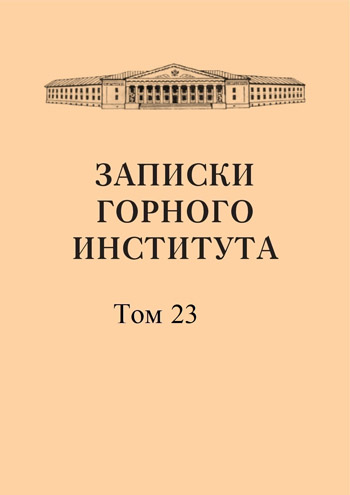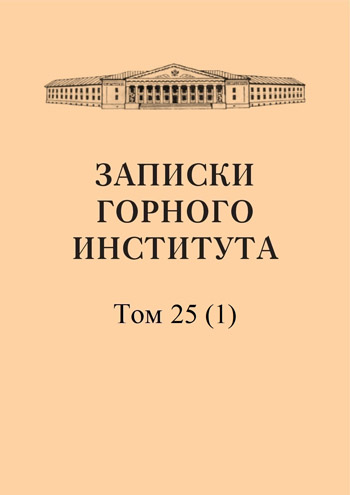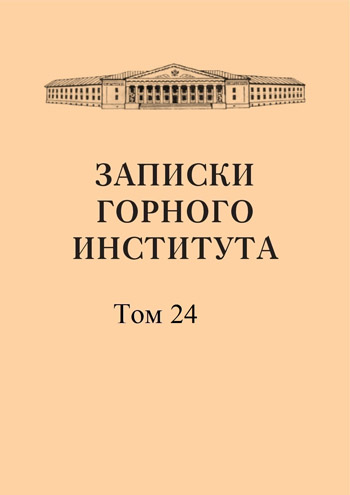-
Date submitted1948-07-10
-
Date accepted1948-09-24
-
Date published1949-11-04
Determination of the density of the stoping zone fastening
- Authors:
- O. B. Bokii
When designing the standards for the consumption of timber for coal mining, it is especially important to correctly determine the consumption of timber for the lining of workings, which is from 50 to 70% of the total timber consumption for coal mining. The purpose of this work is to attempt to provide a method for the theoretical determination of the required density of lining of working faces based on the theory of limiting and equivalent spans developed by V.D. Slesarev. In accordance with this goal, the first two paragraphs of the work provide a brief exposition of the theory of limiting and equivalent spans according to V.D. Slesarev; § 3 provides an application of this theory to the issue of determining the magnitude of rock pressure on the lining of workings with a constant width; § 4 presents the method of successive approximations proposed by the author for calculating the expected pressure on the lining of working faces; § 5 provides a formula for determining the required density of lining of a working face; § 6 provides the results of calculating the pressure according to the proposed method for a specific case of practice—the 1st eastern face at Mine B in the Donetsk Basin.
-
Date submitted1948-07-11
-
Date accepted1948-09-13
-
Date published1949-11-04
On the influence of the cost of transport on the floor crosscuts on the most advantageous dimensions of the mine field
- Authors:
- O. B. Bokii
This article is devoted to the assessment of the impact of the cost of hauling minerals along floor crosscuts on the most advantageous longwall dimensions of the mine field of a vertical shaft opening a suite of steeply dipping seams, determined by the method of L. D. Shevyakov. The cost of hauling minerals along crosscuts during the development of a suite of steeply dipping seams by a vertical shaft with floor crosscuts increases with the increase in the number of floors in the mine field and decreases the most advantageous number of floors against the values given by L. D. Shevyakov's formulas derived without taking this factor into account. In exceptional cases (location of the mine outside the suite with a small angle of dip of the seams), the number of floors determined without taking into account the cost of transport along floor crosscuts may exceed their most advantageous number by 50% or more.
-
Date submitted1948-07-24
-
Date accepted1948-09-22
-
Date published1949-11-04
Methods of transition from projection with numerical marks to spatial images
- Authors:
- G. V. Krunchak
When depicting complex plans on drawings, such as mineral deposits, mine workings, mine plans, etc., in projections with numerical marks, complex drawings are obtained, which are a jumble of plans, established horizons, with an abundance of numerical data. In order to obtain a more complete and visual representation of the depicted mine or deposit, as an addition to the drawing, an axonometric projection is often constructed. The task of constructing an axonometric projection, based on a given projection with numerical marks, is a known difficulty and is accessible to highly qualified persons. The solution scheme for such a problem is presented in the following form: Marking the coordinate axes on the drawing, which depicts orthogonal projections with numerical marks. This moment of construction is aimed at choosing a conditional origin of coordinates and the location of the coordinate axes, if possible, parallel to the main dimensions of the plan, in order to maximally facilitate the construction of the axonometric projection. Construction and selection of distortion indices, as well as construction of a scale for determining the values of distortion indices along the axes and the angles between them. Construction of a secondary projection of the plan. Construction of the axonometric projection of the depicted object itself. The main objective of this article is to develop the simplest method for constructing a spatial image of a body specified by one projection (plan), and to establish the simplest method for transitioning from projections with numerical marks to axonometric ones.
-
Date submitted1948-07-05
-
Date accepted1948-09-09
-
Date published1949-11-04
On the issue of calculating the weights of unknowns when solving normal equations using the Gauss method
- Authors:
- V. L. Romanov
It is known from the theory of accuracy analysis of mediocre measurements that the solution of a system of normal equations by the Gauss method simultaneously yields the weight of the last unknown by order of elimination, which is equal to the coefficient of this unknown in the last equation. It is also known that the weight of the penultimate unknown is easily determined by the weight of the latter. To determine the weights of the remaining unknowns, it is necessary to make more or less significant additional calculations, the difficulty of which increases with the increase in the number of unknowns to be determined. Back in the early 30s of the last century, the astronomer Encke recommended, for example, to determine the weights of unknowns by performing repeated solutions of normal equations by rearranging not only the equations, but also the unknowns themselves, and the number of re-solutions of normal equations (according to Encke) is half the number of normal equations. It is easy to see that Encke's method is based only on theorems on the weights of the last and penultimate unknowns. A more advanced method for calculating the weights of unknowns is the method of undetermined factors (weight coefficients), which was proposed in the first half of the last century and has since become established in astronomical and geodetic practice.
-
Date submitted1948-07-22
-
Date accepted1948-09-01
-
Date published1949-11-04
Stress distribution in rotating prismatic rods
- Authors:
- A. F. Zakharevich
In this paper, we solve the problem of stress distribution in a rod rotating about an axis lying in the plane of the cross-section. We show that in this case the problem is reduced to two completely independent problems. The first of these problems does not depend on the shape of the cross-section contour and can be solved once. The second problem depends significantly on the shape of the contour and coincides with a flat strain state, with the conditions at the ends being satisfied in the sense of Saint-Venant. In particular, we consider the cases of rotation of a hollow round shaft and a rod of elliptical cross-section.
-
Date submitted1948-07-12
-
Date accepted1948-09-02
-
Date published1949-11-04
On engineering-geological assessment of the threat of landslide phenomena
- Authors:
- V. L. Lomtadze
The history of mountain road operation shows that landslides are rare isolated episodes, but usually they are periodically repeated and pose a constant threat to the normal operation of such roads. Identifying areas that pose a threat of landslides and avalanches and assessing the degree of their threat to the road is one of the primary tasks both in designing various measures to protect existing roads and in designing new ones. However, no objective and uniform methodology for assessing the threat of rockfall phenomena has yet been developed. This work is an attempt to provide an approximate methodology for assessing the degree of threat of landslide phenomena to roads. Given the complexity of the solution to the issue under consideration and its novelty, this methodology cannot be considered fully developed, but it can already put an end to the existing inconsistency and provide an objective and uniform approach to this issue.
-
Date submitted1948-07-25
-
Date accepted1948-09-22
-
Date published1949-11-04
On the issue of the operating mode of the electric drive of scraper winches
- Authors:
- L. Shklyarskii
This article is devoted to the issue of analyzing the operating mode of scraper winches. As is known, scraper installations have recently found wide application in various industries. However, despite this, there are no studies of the operating mode of their electric drive and a more substantiated choice of scraper winch drive power in the literature. The analysis of the operating mode of scraper winches is carried out mainly on the basis of power and current diagrams taken by the author under production conditions in the Cheremkhovo coal basin in 1943 (Figs. 1, 2, 3 and 4), as well as on the basis of similar curves given in the existing literature (Figs. 5 and 6). It should be noted that although the diagrams in Figs. 1, 2, 3 and 4 were taken using conventional, non-self-recording measuring electrical devices, the general nature of the scraper winch drive load can be traced using these curves. On the other hand, the diagrams shown in Figs. 5 and 6 were taken with the help of recording measuring instruments and somewhat complicate the analysis, since numerous peaks caused by all sorts of random phenomena sometimes make it difficult to distinguish between idle running and working running of the scraper. Thus, it can be considered that both types of diagrams complement each other when dialysis of the operating mode of the scraper winch drive.
-
Date submitted1948-07-20
-
Date accepted1948-09-27
-
Date published1949-11-04
Genetic relationship of crystal nests with quartz veins and the origin of cavities
- Authors:
- A. E. Karyakin
In the early stages of studying the piezo-optical quartz deposits of the Northern Urals, some geologists believed that crystal nests had no genetic connection with quartz veins. Geologists came to this conclusion because at that time the bulk of piezo-optical quartz was mined not from crystal nests, but from placers, and geologists did not have enough data to correctly resolve this issue. Later, in connection with the transition to exploration of primary deposits, it was established that in most cases quartz veins and crystal nests are located in the same cracks. The asymmetrical arrangement of crystal nests in relation to quartz veins does not give reason to deny the genetic relationship of both, but only indicates a later formation of crystal nests compared to quartz veins. In all likelihood, after the formation of quartz veins, there was a fairly long intermineralization break, after which crack formation and the flow of hydrothermal solutions resumed. The duration of the intermineralization break can be judged by the sharp change in the nature of the hydrothermal solutions - from highly supersaturated with silicic acid (during the formation of quartz veins) to normal (during the formation of quartz crystals). Consequently, quartz veins and crystal nests are derivatives of a single magmatic chamber, but they were only formed in different phases of a single hydrothermal process.
-
Date submitted1948-07-08
-
Date accepted1948-09-22
-
Date published1949-11-04
On the regularity of open-pit mining technology in the mine energy distribution of local importance
- Authors:
- S. A. Alatortsev
Mining technology, atmospheric and natural conditions in which the deposit is exploited determine the special specificity inherent in open-pit mines. The influence, role and significance of mining specificity are so significant and natural that in many cases they determine the basic principles of construction and operation of local mine power distribution systems within the established boundaries of open-pit mining of a deposit. However, the following fundamental issues remain unresolved in the mine electric power industry of open-pit mining: 1) local mine power distribution systems and types of open-pit networks for specific mining conditions constructed within the maximum established boundaries of open-pit mining of a deposit; 2) the optimal number and location of open-pit power supply points for periodically moving electrified mining machines in free running mode; 3) organization of planned operation of power distribution devices in open-pit mines with inconstant working horizons, with a periodically moving mining front and gradual advancement of excavator faces; 4) classification of mine power distribution systems and devices of local importance. The author's present work is devoted to the listed fundamental issues. Open-pit mining is located in special, unique and difficult conditions, as a result of which, without preliminary generalized study and research of mining specifics, it is impossible to create new, more advanced power distribution systems and electrical equipment for them, as well as rationally plan and operate mining and power engineering in open-pit mines.
-
Date submitted1948-07-13
-
Date accepted1948-09-14
-
Date published1949-11-04
Some issues of uneven movement of groundwater in artesian strata
- Authors:
- V. I. Davidovich
Hydraulic engineering urgently requires the most complete and in-depth development of certain scientific and technical problems for the purpose of a correct quantitative and qualitative assessment of the movement of groundwater both in natural conditions and in conditions created as a result of an artificial change in the movement regime. Of these problems, the question of the movement of groundwater in artesian strata is of significant interest. Note that while the theory of the movement of underground gravity flows and its practical application have been developed in great detail and were set out with sufficient completeness by Academician N. N. Pavlovskii in his well-known work "Uneven Movement of Groundwater", movement in artesian strata has been studied extremely poorly and very little attention has been and is being paid to this issue. When designing hydraulic structures and reservoirs, when analyzing the regime of groundwater, as well as in many other cases, it is often necessary to give a technical assessment of the movement in artesian strata.
-
Date submitted1948-07-13
-
Date accepted1948-09-26
-
Date published1949-11-04
Determination of tenion in hoisting ropes for low ascent and descent heights
- Authors:
- N. P. Neronov
The problem of determining stresses in hoisting ropes and the related question of longitudinal vibrations of elastic rods in terms of formulation and solution methods have a long history. The present work aims to continue the analytical development of the problem of determining stresses in hoisting ropes of variable length in order to supplement the theoretical material necessary for rational strength calculations of hoisting ropes. The calculation itself is carried out by combining the most unfavorable circumstances in terms of strength, taking into account both the normal lifting mode and its special cases. The methodology of such calculation requires additional research and is not included in our task.
-
Date submitted1948-07-28
-
Date accepted1948-09-12
-
Date published1949-11-04
Frontal self-loading of coal in longwalls is the most important means of fulfilling the five-year plan of the coal industry in 4 years
- Authors:
- Ya. B. Kalnitskii
Implementation of mechanization of coal loading in the working face is one of the most important problems of the Soviet coal industry in the 4th Stalin Five-Year Plan. In the "Law on the Five-Year Plan for the Restoration and Development of the National Economy of the USSR for 1946-1950" it is written: "In order to implement the established program for the growth of coal production, construction and increase in labor productivity - mechanize labor-intensive processes in the coal industry in every possible way, in particular, ensure the widespread implementation of work on the mechanization of coal loading and rock loading." There are three main possible ways of mechanization of coal loading in the working face: Partial mechanization of loading, i.e. loading onto the conveyor not all of the extracted coal, but some of it. Full mechanization of loading, performed by specialized loading machines. Complex mechanization of coal loading and extraction; the executive machine in this case is a mining combine or cutting-cutting-bulking machine. The second and third methods require the creation of highly sophisticated designs of bulk machines and mining combines.


